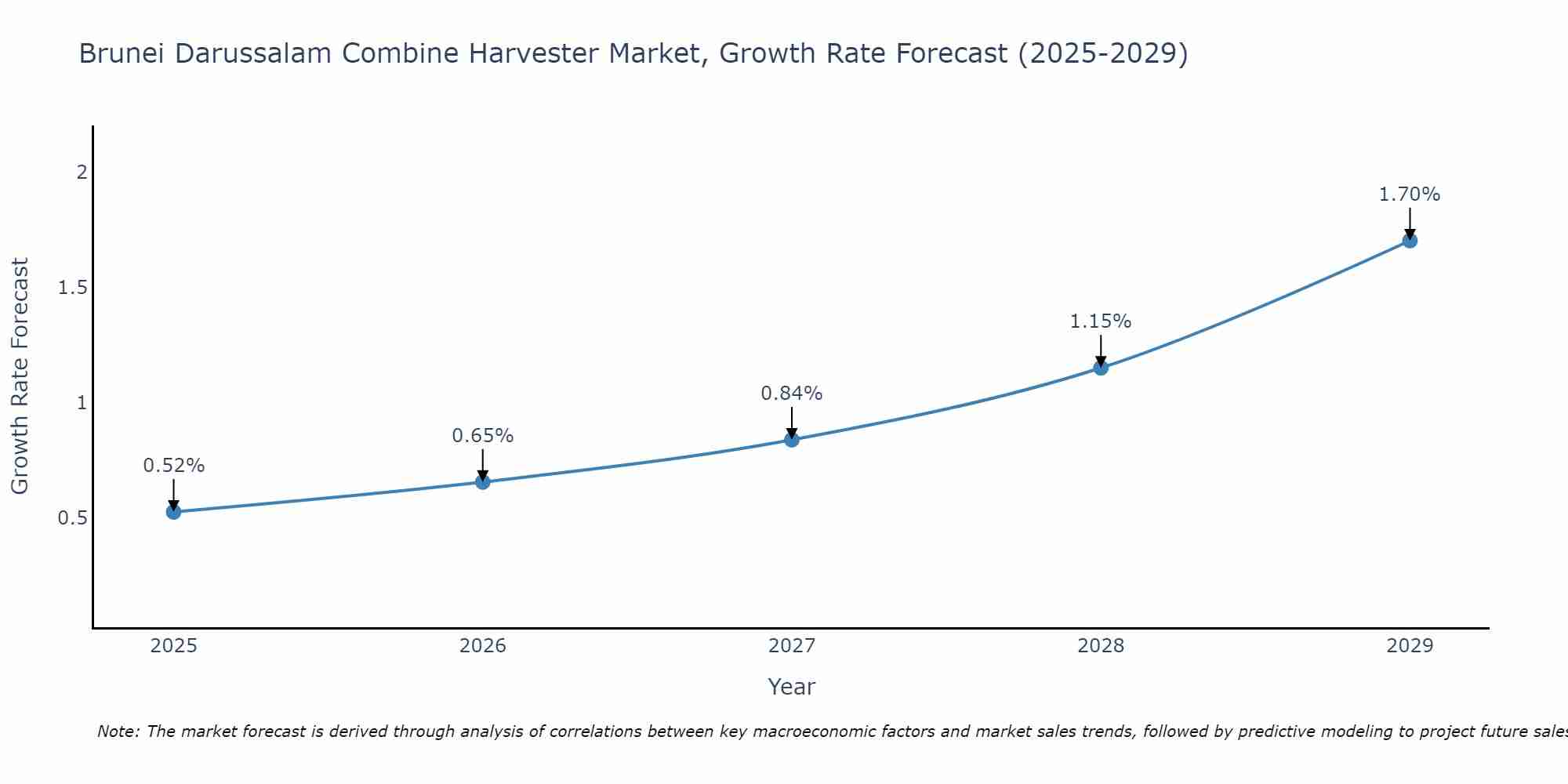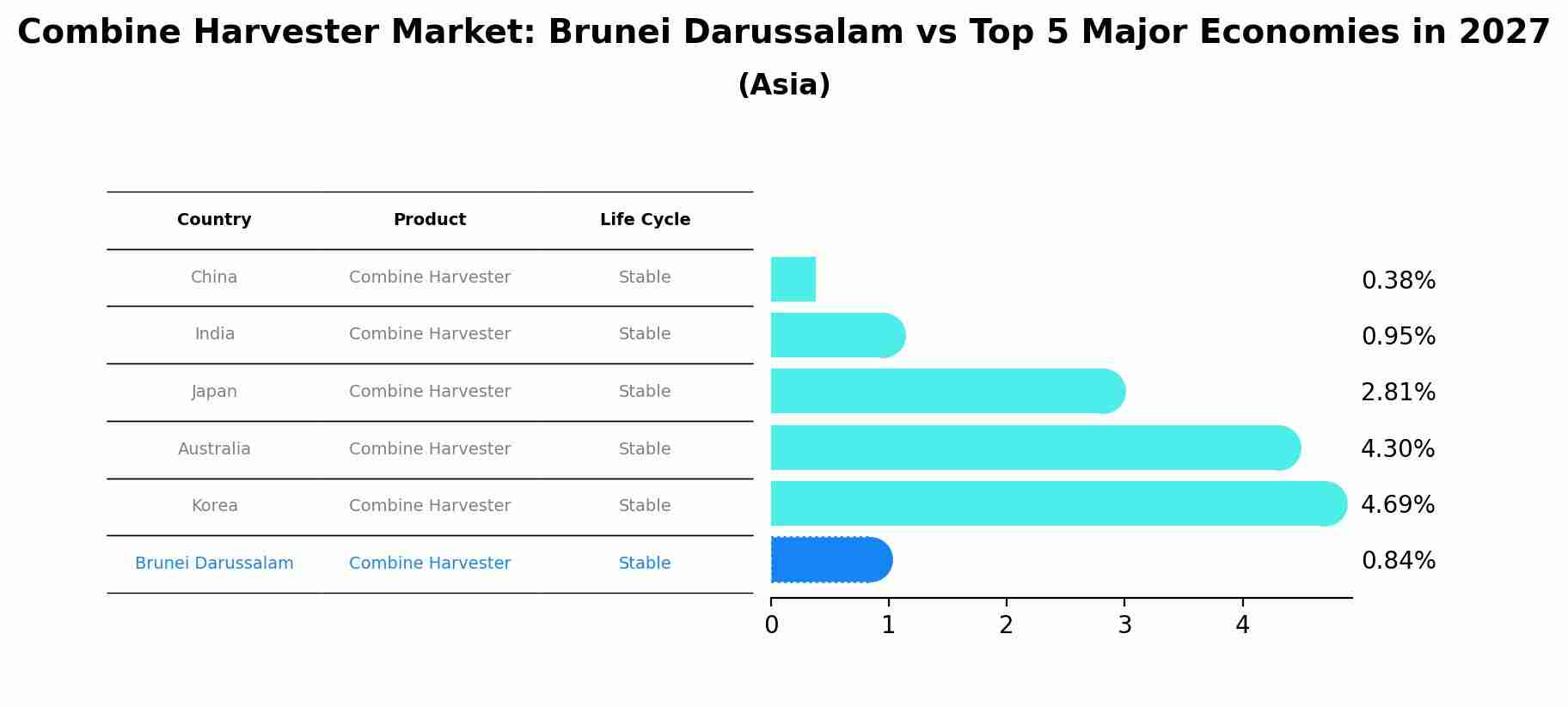Brunei Combine Harvester Market (2025-2031) | Segmentation, Outlook, Analysis, Trends, Revenue, Growth, Forecast, Share, Size, Value, Industry & Companies
| Product Code: ETC5398214 | Publication Date: Nov 2023 | Updated Date: Oct 2025 | Product Type: Market Research Report | |
| Publisher: 6Wresearch | Author: Bhawna Singh | No. of Pages: 60 | No. of Figures: 30 | No. of Tables: 5 |
Brunei Darussalam Combine Harvester Market Size Growth Rate
The Brunei Darussalam Combine Harvester Market is likely to experience consistent growth rate gains over the period 2025 to 2029. The growth rate starts at 0.52% in 2025 and reaches 1.70% by 2029.

Combine Harvester Market: Brunei Darussalam vs Top 5 Major Economies in 2027 (Asia)
The Combine Harvester market in Brunei Darussalam is projected to grow at a stable growth rate of 0.84% by 2027, within the Asia region led by China, along with other countries like India, Japan, Australia and South Korea, collectively shaping a dynamic and evolving market environment driven by innovation and increasing adoption of emerging technologies.

Brunei Combine Harvester Market Overview
The Combine Harvester market in Brunei focuses on agricultural machinery used for harvesting crops efficiently. These machines combine multiple harvesting processes into one operation, including reaping, threshing, and winnowing. The demand for combine harvesters in Brunei is influenced by the country`s agricultural sector`s need for modernization and increased productivity. As Brunei continues to invest in improving agricultural efficiency, the market for advanced and high-capacity combine harvesters is expected to grow. Key factors driving this market include technological advancements and the need for labor-saving equipment in agriculture.
Drivers of the market
The Brunei Combine Harvester market is influenced by the need for efficient agricultural machinery to enhance crop harvesting processes. As Brunei continues to invest in improving its agricultural sector, the demand for advanced combine harvesters that increase productivity and reduce labor costs rises. Additionally, the adoption of modern farming techniques and the government`s focus on achieving food security drive the growth of this market.
Challenges of the market
The Brunei combine harvester market faces several hurdles, including high costs and limited local support. The initial investment for combine harvesters is substantial, and the cost can be prohibitive for many local farmers. Additionally, there is a limited network of service providers and spare parts suppliers in Brunei, making maintenance and repairs challenging. The relatively small scale of agricultural operations in Brunei also means that the demand for combine harvesters is lower, which can lead to difficulties in justifying the investment for many potential buyers.
Government Policy of the market
Brunei`s agricultural policies support the modernization of farming equipment, including combine harvesters. The government offers incentives for importing advanced machinery and implements standards to ensure safety and environmental compliance. Import tariffs may be adjusted to promote the adoption of modern agricultural technology, and there are guidelines for maintenance and operational standards to enhance agricultural productivity.
Key Highlights of the Report:
- Brunei Combine Harvester Market Outlook
- Market Size of Brunei Combine Harvester Market, 2024
- Forecast of Brunei Combine Harvester Market, 2031
- Historical Data and Forecast of Brunei Combine Harvester Revenues & Volume for the Period 2021-2031
- Brunei Combine Harvester Market Trend Evolution
- Brunei Combine Harvester Market Drivers and Challenges
- Brunei Combine Harvester Price Trends
- Brunei Combine Harvester Porter`s Five Forces
- Brunei Combine Harvester Industry Life Cycle
- Historical Data and Forecast of Brunei Combine Harvester Market Revenues & Volume By Cutting Width for the Period 2021-2031
- Historical Data and Forecast of Brunei Combine Harvester Market Revenues & Volume By Small Size Combine Harvester for the Period 2021-2031
- Historical Data and Forecast of Brunei Combine Harvester Market Revenues & Volume By Large Size Combine Harvester for the Period 2021-2031
- Historical Data and Forecast of Brunei Combine Harvester Market Revenues & Volume By Type for the Period 2021-2031
- Historical Data and Forecast of Brunei Combine Harvester Market Revenues & Volume By Wheel Type Combine Harvester for the Period 2021-2031
- Historical Data and Forecast of Brunei Combine Harvester Market Revenues & Volume By Crawler Type Combine Harvester for the Period 2021-2031
- Historical Data and Forecast of Brunei Combine Harvester Market Revenues & Volume By Power Source for the Period 2021-2031
- Historical Data and Forecast of Brunei Combine Harvester Market Revenues & Volume By Tractor Pulled/PTO Powered Combine Harvester for the Period 2021-2031
- Historical Data and Forecast of Brunei Combine Harvester Market Revenues & Volume By Self-Propelled Combine Harvester for the Period 2021-2031
- Brunei Combine Harvester Import Export Trade Statistics
- Market Opportunity Assessment By Cutting Width
- Market Opportunity Assessment By Type
- Market Opportunity Assessment By Power Source
- Brunei Combine Harvester Top Companies Market Share
- Brunei Combine Harvester Competitive Benchmarking By Technical and Operational Parameters
- Brunei Combine Harvester Company Profiles
- Brunei Combine Harvester Key Strategic Recommendations
Frequently Asked Questions About the Market Study (FAQs):
1 Executive Summary |
2 Introduction |
2.1 Key Highlights of the Report |
2.2 Report Description |
2.3 Market Scope & Segmentation |
2.4 Research Methodology |
2.5 Assumptions |
3 Brunei Combine Harvester Market Overview |
3.1 Brunei Country Macro Economic Indicators |
3.2 Brunei Combine Harvester Market Revenues & Volume, 2021 & 2031F |
3.3 Brunei Combine Harvester Market - Industry Life Cycle |
3.4 Brunei Combine Harvester Market - Porter's Five Forces |
3.5 Brunei Combine Harvester Market Revenues & Volume Share, By Cutting Width, 2021 & 2031F |
3.6 Brunei Combine Harvester Market Revenues & Volume Share, By Type, 2021 & 2031F |
3.7 Brunei Combine Harvester Market Revenues & Volume Share, By Power Source, 2021 & 2031F |
4 Brunei Combine Harvester Market Dynamics |
4.1 Impact Analysis |
4.2 Market Drivers |
4.2.1 Increasing adoption of mechanized farming methods in Brunei |
4.2.2 Government support and subsidies for agricultural mechanization |
4.2.3 Growing demand for higher efficiency and productivity in agriculture sector |
4.3 Market Restraints |
4.3.1 High initial cost of combine harvesters |
4.3.2 Limited awareness and technical know-how among farmers |
4.3.3 Dependence on external factors like weather conditions for agricultural output |
5 Brunei Combine Harvester Market Trends |
6 Brunei Combine Harvester Market Segmentations |
6.1 Brunei Combine Harvester Market, By Cutting Width |
6.1.1 Overview and Analysis |
6.1.2 Brunei Combine Harvester Market Revenues & Volume, By Small Size Combine Harvester, 2021-2031F |
6.1.3 Brunei Combine Harvester Market Revenues & Volume, By Large Size Combine Harvester, 2021-2031F |
6.2 Brunei Combine Harvester Market, By Type |
6.2.1 Overview and Analysis |
6.2.2 Brunei Combine Harvester Market Revenues & Volume, By Wheel Type Combine Harvester, 2021-2031F |
6.2.3 Brunei Combine Harvester Market Revenues & Volume, By Crawler Type Combine Harvester, 2021-2031F |
6.3 Brunei Combine Harvester Market, By Power Source |
6.3.1 Overview and Analysis |
6.3.2 Brunei Combine Harvester Market Revenues & Volume, By Tractor Pulled/PTO Powered Combine Harvester, 2021-2031F |
6.3.3 Brunei Combine Harvester Market Revenues & Volume, By Self-Propelled Combine Harvester, 2021-2031F |
7 Brunei Combine Harvester Market Import-Export Trade Statistics |
7.1 Brunei Combine Harvester Market Export to Major Countries |
7.2 Brunei Combine Harvester Market Imports from Major Countries |
8 Brunei Combine Harvester Market Key Performance Indicators |
8.1 Average operational hours of combine harvesters in Brunei |
8.2 Adoption rate of precision farming technologies in the country |
8.3 Percentage increase in average farm yield post adoption of combine harvesters |
9 Brunei Combine Harvester Market - Opportunity Assessment |
9.1 Brunei Combine Harvester Market Opportunity Assessment, By Cutting Width, 2021 & 2031F |
9.2 Brunei Combine Harvester Market Opportunity Assessment, By Type, 2021 & 2031F |
9.3 Brunei Combine Harvester Market Opportunity Assessment, By Power Source, 2021 & 2031F |
10 Brunei Combine Harvester Market - Competitive Landscape |
10.1 Brunei Combine Harvester Market Revenue Share, By Companies, 2024 |
10.2 Brunei Combine Harvester Market Competitive Benchmarking, By Operating and Technical Parameters |
11 Company Profiles |
12 Recommendations | 13 Disclaimer |
- Single User License$ 1,995
- Department License$ 2,400
- Site License$ 3,120
- Global License$ 3,795
Search
Thought Leadership and Analyst Meet
Our Clients
Related Reports
- Germany Breakfast Food Market (2026-2032) | Industry, Share, Growth, Size, Companies, Value, Analysis, Revenue, Trends, Forecast & Outlook
- Australia Briquette Market (2025-2031) | Growth, Size, Revenue, Forecast, Analysis, Trends, Value, Share, Industry & Companies
- Vietnam System Integrator Market (2025-2031) | Size, Companies, Analysis, Industry, Value, Forecast, Growth, Trends, Revenue & Share
- ASEAN and Thailand Brain Health Supplements Market (2025-2031) | Strategy, Consumer Insights, Analysis, Investment Trends, Opportunities, Growth, Size, Share, Industry, Revenue, Segments, Value, Segmentation, Supply, Forecast, Restraints, Outlook, Competition, Drivers, Trends, Demand, Pricing Analysis, Competitive, Strategic Insights, Companies, Challenges
- ASEAN Bearings Market (2025-2031) | Strategy, Consumer Insights, Analysis, Investment Trends, Opportunities, Growth, Size, Share, Industry, Revenue, Segments, Value, Segmentation, Supply, Forecast, Restraints, Outlook, Competition, Drivers, Trends, Demand, Pricing Analysis, Competitive, Strategic Insights, Companies, Challenges
- Europe Flooring Market (2025-2031) | Outlook, Share, Industry, Trends, Forecast, Companies, Revenue, Size, Analysis, Growth & Value
- Saudi Arabia Manlift Market (2025-2031) | Outlook, Size, Growth, Trends, Companies, Industry, Revenue, Value, Share, Forecast & Analysis
- Uganda Excavator, Crane, and Wheel Loaders Market (2025-2031) | Strategy, Consumer Insights, Analysis, Investment Trends, Opportunities, Growth, Size, Share, Industry, Revenue, Segments, Value, Segmentation, Supply, Forecast, Restraints, Outlook, Competition, Drivers, Trends, Demand, Pricing Analysis, Competitive, Strategic Insights, Companies, Challenges
- Rwanda Excavator, Crane, and Wheel Loaders Market (2025-2031) | Strategy, Consumer Insights, Analysis, Investment Trends, Opportunities, Growth, Size, Share, Industry, Revenue, Segments, Value, Segmentation, Supply, Forecast, Restraints, Outlook, Competition, Drivers, Trends, Demand, Pricing Analysis, Competitive, Strategic Insights, Companies, Challenges
- Kenya Excavator, Crane, and Wheel Loaders Market (2025-2031) | Strategy, Consumer Insights, Analysis, Investment Trends, Opportunities, Growth, Size, Share, Industry, Revenue, Segments, Value, Segmentation, Supply, Forecast, Restraints, Outlook, Competition, Drivers, Trends, Demand, Pricing Analysis, Competitive, Strategic Insights, Companies, Challenges
Industry Events and Analyst Meet
Whitepaper
- Middle East & Africa Commercial Security Market Click here to view more.
- Middle East & Africa Fire Safety Systems & Equipment Market Click here to view more.
- GCC Drone Market Click here to view more.
- Middle East Lighting Fixture Market Click here to view more.
- GCC Physical & Perimeter Security Market Click here to view more.
6WResearch In News
- Doha a strategic location for EV manufacturing hub: IPA Qatar
- Demand for luxury TVs surging in the GCC, says Samsung
- Empowering Growth: The Thriving Journey of Bangladesh’s Cable Industry
- Demand for luxury TVs surging in the GCC, says Samsung
- Video call with a traditional healer? Once unthinkable, it’s now common in South Africa
- Intelligent Buildings To Smooth GCC’s Path To Net Zero


















